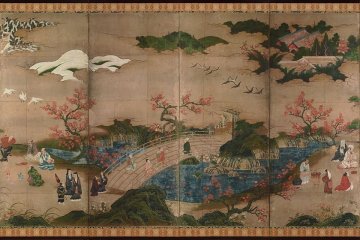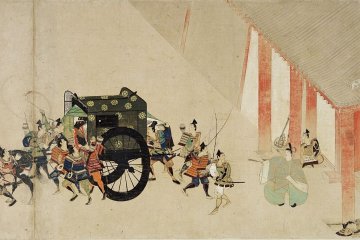Overview
Paintings form an integral category under Japan's National Treasure listings with some one hundred and sixty plus paintings designated as National Treasures. Both Kyoto and Tokyo hold the majority of the nation's treasures with Tokyo home to close to fifty works. With numerous themes such as Buddhist, landscapes, portraits and court scenes popular, the collections within Tokyo date back to the 9th century. Almost half of Tokyo's collection are held by the Tokyo National Museum with other locations home to a smaller share. Here is a simple guide to where in Tokyo these painting National Treasure can be found.
Tokyo National Museum
As the leading location for National Treasures in the capital, the collection of the Tokyo National Museum is filled with heritage-imbued works like the 11th-century biography of Prince Shotoku and the 13th-century on of Priest Ippen. Religious paintings abound too, with Kokuzo Bosatsu and Kujaku Myoo works both from the 12th century and a beautiful religiously inspired 13th-century landscape of Sakyamuni descending a winter mountain after ascetic practice. The Scroll of Hell and another scroll of 'hungry ghosts' are another pair of fascinating paintings dating from the 12th century.
Other works include social scenes of a family enjoying a cool evening, one of merrymaking under the trees and another showing scenes of Kyoto that all date back to the 17th century. Floral scenes of hibiscuses from the 12th century, a cypress painting from late 16th century, a pine tree painting from the 16th century and one of a reader in a bamboo grove from the 15th century also appeal. A couple of landscape works from the 15th and 16th centuries are also on display, along with a Chinese landscape from the 18th century.
Location: 13-9 Ueno Park, Taito-ku, Tokyo, 〒110-8712 (nearest station: Ueno Station, JR Yamanote Line)
Gotoh Museum
The Gotoh Museum features a painting from the early 12th century that details several chapters from the famous Tale of Genji story. Two more 13th-century paintings, one of Huineng, a semi-legendary figure in Chinese Buddhism and an emaki picture scroll of the Tale of Genji author, Murasaki Shikibu, also feature.
Location: 3-9-25 Kaminoge, Setagaya-ku, Tokyo 〒158-8510 (nearest station: Kaminoge Station, Tokyu Oimachi Line)
Nezu Museum
The Nezu Museum holds a number of nature-themed works like a 13th-century painting of the famous Nachi Waterfall in Wakayama Prefecture and a 12th-century quail painting imported from China. An iris screen work from the 18th century along with a fishing village from the 13th century round out the collection.
Location: 6-5-1 Minami-aoyama, Minato-ku, Tokyo 〒107-0062(nearest station: Omotesando Station, Hanzomon Line)
Hatakeyama Memorial Museum of Fine Art
Expressive works like the evening bell from temple shrouded in mist from the 12th century an apple blossom from the same period are held by the Hatakeyama Memorial Museum of Fine Art.
Location: 2-20-12 Shirokanedai, Minato-ku, Tokyo 〒108-0071 (nearest station: Takanawadai Station, Toei Asakusa Line)
Seikado Bunko Art Museum
The Seikado Bunko Art Museum holds a 17th-century painting of two chapters from the famous story The Tale of Genji.
Location: 2-20-12 Shirokanedai, Minato-ku, Tokyo 〒108-0071 (nearest station: Takanawadai Station, Toei Asakusa Line)
Okura Museum of Art
A 13th-century painting of cavalry from the Imperial Guard can be found at the Okura Museum of Art.
Location: 2-10-3 Toranomon, Minato-ku, Tokyo 〒105-0001 (nearest station: Roppongi-itchome Station, Namboku Line)
Mitsui Memorial Museum
A lovely landscape painting of pine trees in the snow from the 18th century is on display at the Mitsui Memorial Museum.
Location: 2-1-1 Nihonbashi-muromachi, Chuo-ku, Tokyo 〒103-0022 (nearest station: Mitsukoshimae Station, Ginza Line)
Idemitsu Museum of Arts
The Idemitsu Museum of Arts is home to a famous scroll painting depicting the famous Otemmon Conspiracy that occurred in the 9th century in Kyoto.
Location: 3-1-1 Marunouchi, Chiyoda-ku, Tokyo 〒100-0005 (nearest station: Yurakucho Station, Yurakucho Line)









